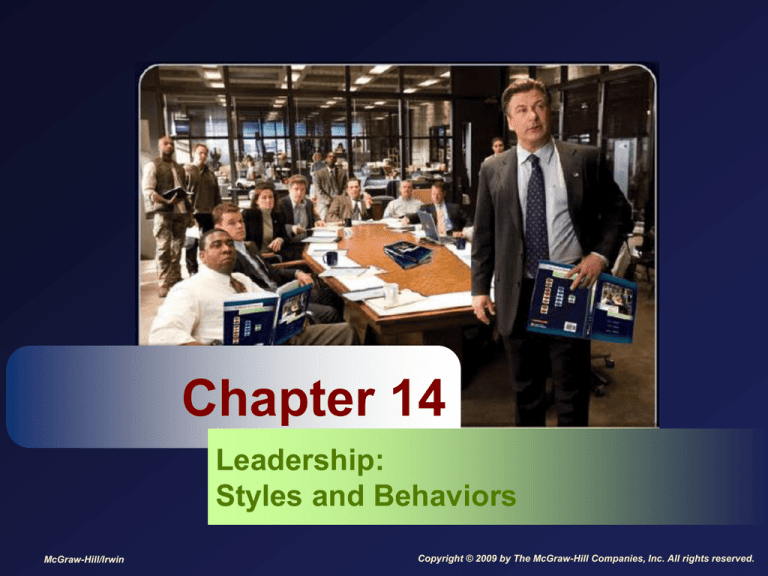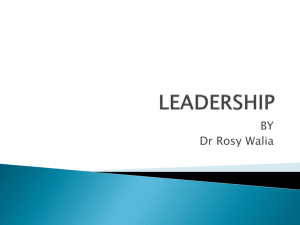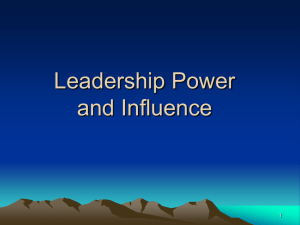
Chapter 14
Leadership:
Styles and Behaviors
McGraw-Hill/Irwin
Copyright © 2009 by The McGraw-Hill Companies, Inc. All rights reserved.
Learning Goals
What is the “best” leadership style?
What four styles can leaders use to make
decisions?
What traits and characteristics are related
to leader emergence? What traits and
characteristics are related to leader
effectiveness?
Slide
14-2
Learning Goals, Cont’d
How does transformational leadership differ
from transactional leadership? What kinds
of behaviors underlie transformational
leadership?
How does leadership affect job
performance and organizational
commitment?
Can leaders be trained to be more
effective?
Slide
14-3
Leadership
Leadership is the use of power and
influence to direct the activities of followers
toward goal achievement.
How leaders get the power and influence
needed to direct others (Chapter 13).
How leaders actually use their power and
influence in an effective way.
Slide
14-4
Leader Effectiveness
Leader effectiveness is the degree to which the
leader’s actions result in the achievement of the
unit’s goals, the continued commitment of the
unit’s employees, and the development of
mutual trust, respect, and obligation in leader–
member dyads.
Most studies have concluded that traits are more
predictive of leader emergence (i.e., who
becomes a leader in the first place) than they
are of leader effectiveness (i.e., how well people
actually do in a leadership role).
Slide
14-5
Table 14-2
Traits/Characteristics Related to
Leader Emergence and Effectiveness
Slide
14-6
Leadership Modeling Behaviors
As the leader YOU set both the culture
and norms of behavior for your work
group.
If employees are motivated, they will look
to the leader for appropriate behaviors and
be influenced by the leader’s attitudes.
Slide
14-7
You Can Influence Work Attitudes
Through YOUR Values
A Manager Should Model These
Values to Achieve Positive
Attitudes and Ethical Behavior
Achievement
Concern for Others
Honesty
Fairness
Slide
14-8
McGregor’s Theory X and Theory Y
Leaders and managers who hold Theory X assumptions
believe that employees are inherently lazy and lack
ambition.
A negative perspective on human behavior.
Leaders and managers who hold Theory Y assumptions
believe that most employees do not dislike work and
want to make useful contributions to the organization.
A positive perspective on human behavior.
Slide
14-9
McGraw-Hill
© 2004 The McGraw-Hill Companies, Inc. All rights reserved.
McGregor’s Theory X & Theory
Y Leadership Styles
Leaders operating under “Theory X” assume:
•Employees are lazy.
•Employees must be coerced and threatened for motivation.
•Employees will avoid responsibility.
•Employees have no ambition.
Leaders operating under “Theory Y” assume:
•Employees want to work.
•Committed employees can be self directed.
•Employees want responsibility.
•Employees have an ability to make innovative decisions.
Slide
14-10
Theories X & Y As a Continuum of
Leadership Styles
Slide
14-11
Leadership Continuum And
Employee Freedom
Slide
14-12
Question: What’s the
BEST Leadership
Style????
George Patton
Sir Richard Branson
Donald Trump
Ben Cohen & Jerry
Greenfield
Joseph Stalin
Oprah Winfrey
Slide
14-13
Leader Decision-Making Styles
Delegative
Style
Facilitative
Style
Consultative
Style
High Follower
Control
Autocratic
Style
High Leader
Control
Figure 14-2
Slide
14-14
Decision-Making Styles
Decision-making styles capture how a leader
decides as opposed to what a leader decides.
Autocratic style - the leader makes the decision
alone without asking for the opinions or
suggestions of the employees in the work unit.
Consultative style - the leader presents the
problem to individual employees or a group of
employees, asking for their opinions and
suggestions before ultimately making the
decision him- or herself.
Slide
14-15
Decision-Making Styles, Cont’d
Facilitative style - the leader presents the
problem to a group of employees and seeks
consensus on a solution, making sure that his or
her own opinion receives no more weight than
anyone else’s.
Delegative style - the leader gives an individual
employee or a group of employees the
responsibility for making the decision within
some set of specified boundary conditions.
Slide
14-16
Transactional &
Transformational Leadership
Transformational leadership involves
inspiring followers to commit to a shared
vision that provides meaning to their work
while also serving as a role model who
helps followers develop their own potential
and view problems from new perspectives.
Laissez-faire leadership (i.e., hands-off)
is the avoidance of leadership altogether.
Slide
14-17
Transactional & Transformational
Leadership, Cont’d
Transactional leadership occurs when the
leader rewards or disciplines the follower
depending on the adequacy of the follower’s
performance.
With passive management-by-exception, the leader
waits around for mistakes and errors, then takes
corrective action as necessary.
With active management-by-exception, the leader
arranges to monitor mistakes and errors actively and
again takes corrective action when required.
Contingent reward happens when the leader attains
follower agreement on what needs to be done using
promised or actual rewards in exchange for adequate
performance.
Slide
14-18
Dimensions of Transformational
Leadership
Idealized influence involves behaving in ways
that earn the admiration, trust, and respect of
followers, causing followers to want to identify
with and emulate the leader.
“The leader instills pride in me for being associated
with him/her.”
Inspirational motivation involves behaving in
ways that foster an enthusiasm for and
commitment to a shared vision of the future.
“The leader articulates a compelling vision of the
future.”
Slide
14-19
Dimensions of Transformational
Leadership, Cont’d
Intellectual stimulation involves behaving in
ways that challenge followers to be innovative
and creative by questioning assumptions and
reframing old situations in new ways.
“The leader gets others to look at problems from
many different angles.”
Individualized consideration involves
behaving in ways that help followers achieve
their potential through coaching, development,
and mentoring.
“The leader spends time teaching and coaching.”
Slide
14-20
Figure 14-5
Laissez-Faire, Transactional, and
Transformational Leadership
Slide
14-21
Figure 14-3
The Time-Driven Model of
Leadership
Slide
14-22
Figure 14-4
The Life Cycle Theory of
Leadership
Slide
14-23
How Important is Leadership?
Transformational leadership affects the job
performance of the employees who report to the
leader.
Employees with transformational leaders tend to
have higher levels of task performance and
engage in higher levels of citizenship behaviors.
Employees have higher levels of motivation and trust
their leader more.
Employees with transformational leaders tend to
be more committed to their organization.
Slide
14-24
Figure 14-7
Effects of Transformational Leadership
on Performance and Commitment
Slide
14-25
Substitutes for Leadership
Substitutes for leadership model suggests
that certain characteristics of the situation can
constrain the influence of the leader, making it
more difficult for the leader to influence
employee performance.
Substitutes reduce the importance of the leader
while simultaneously providing a direct benefit to
employee performance.
Neutralizers only reduce the importance of the
leader—they themselves have no beneficial impact
on performance.
Slide
14-26
Table 14-5
Leader Substitutes and
Neutralizers
Slide
14-27
Takeaways
Leadership is defined as the use of power and
influence to direct the activities of followers
toward goal achievement. An “effective
leader” improves the performance and wellbeing of the overall unit. An “effective leader”
also cultivates high-quality leader–member
exchange relationships on a dyadic basis
through role taking and role making
processes.
Leader emergence has been linked to a
number of traits, some of which also predict
leader effectiveness.
Slide
14-28
Takeaways, Cont’d
Leaders can use a number of styles to make
decisions. Beginning with high leader control and
moving to high follower control, they include
autocratic, consultative, facilitative, and
delegative styles. According to the time-driven
model of leadership, the appropriateness of these
styles depends on decision significance, the
importance of commitment, leader expertise, the
likelihood of commitment, shared objectives,
employee expertise, and teamwork skills.
Slide
14-29
Takeaways, Cont’d
Transactional leadership emphasizes “carrot-andstick” approaches to motivating employees, whereas
transformational leadership fundamentally changes
the way employees view their work. The specific
behaviors that underlie transformational leadership
include the “Four Is”: idealized influence, inspirational
motivation, intellectual stimulation, and individualized
consideration.
Transformational leadership has a moderate positive
relationship with job performance and a strong
positive relationship with organizational commitment.
It has stronger effects on these outcomes than other
leadership behaviors.
Slide
14-30






